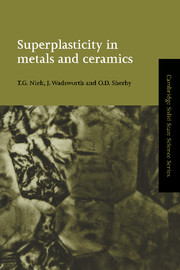Book contents
- Frontmatter
- Contents
- Preface
- Chapter 1 Introduction
- Chapter 2 Key historical contributions
- Chapter 3 Types of superplasticity
- Chapter 4 Mechanisms of high-temperature deformation and phenomenological relations for fine-structure superplasticity
- Chapter 5 Fine-structure superplastic metals
- Chapter 6 Fine-structure superplastic ceramics
- Chapter 7 Fine-structure superplastic intermetallics
- Chapter 8 Fine-structure superplastic composites and laminates
- Chapter 9 High-strain-rate superplasticity
- Chapter 10 Ductility and fracture in superplastic materials
- Chapter 11 Internal-stress superplasticity (ISS)
- Chapter 12 Other possible superplasticity mechanisms
- Chapter 13 Enhanced powder consolidation through superplastic flow
- Chapter 14 Superplastic forming and diffusion bonding
- Chapter 15 Commercial examples of superplastic products
- Index
Chapter 15 - Commercial examples of superplastic products
Published online by Cambridge University Press: 15 October 2009
- Frontmatter
- Contents
- Preface
- Chapter 1 Introduction
- Chapter 2 Key historical contributions
- Chapter 3 Types of superplasticity
- Chapter 4 Mechanisms of high-temperature deformation and phenomenological relations for fine-structure superplasticity
- Chapter 5 Fine-structure superplastic metals
- Chapter 6 Fine-structure superplastic ceramics
- Chapter 7 Fine-structure superplastic intermetallics
- Chapter 8 Fine-structure superplastic composites and laminates
- Chapter 9 High-strain-rate superplasticity
- Chapter 10 Ductility and fracture in superplastic materials
- Chapter 11 Internal-stress superplasticity (ISS)
- Chapter 12 Other possible superplasticity mechanisms
- Chapter 13 Enhanced powder consolidation through superplastic flow
- Chapter 14 Superplastic forming and diffusion bonding
- Chapter 15 Commercial examples of superplastic products
- Index
Summary
Titanium alloys
Superplastic forming of titanium alloys has been widely used by the aerospace industry. A well-known example of superplastic forming carried out at Rockwell International using a Ti–6Al–4V alloy was shown in Figure 14.2. The component shown was a nacelle center-beam frame. (A number of such parts formed a proposed structure in the B–1 aircraft.) In this example, a single superplastic forming and diffusion bonding operation was designed to replace a production route which had involved the forming of eight separate pieces of the same alloy, which then had to be joined together with 96 fasteners. Estimated cost savings of 55% and weight savings of 33% were estimated using this fabrication route compared with the conventional production technique. Superplastically formed Ti–6Al–4V was also used for service doors and panels for Airbus aircraft, missile fins, turbofan blades, and turbine disks.
For non-aerospace applications, the most significant commercial product is probably golf club heads, shown in Figure 15.1. A titanium golf club head offers a light weight, large volume, and a wide sweet spot area. It is now produced in both Japan and China. In Japan, the head is made of SP–700 Ti alloy which has the nominal composition of Ti–4.5Al–3V–2Fe–2Mo. The alloy, marketed by Nippon Kokan (NKK), features a low SPF temperature (as low as 775 °C) for the maximum formability, and can be age-hardened.
- Type
- Chapter
- Information
- Superplasticity in Metals and Ceramics , pp. 256 - 269Publisher: Cambridge University PressPrint publication year: 1997



